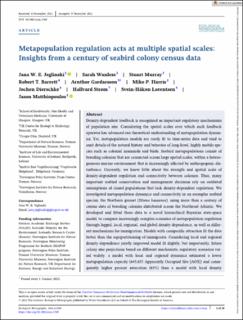| dc.contributor.author | Jeglinski, Jana W.E. | |
| dc.contributor.author | Wanless, Sarah | |
| dc.contributor.author | Murray, Stuart | |
| dc.contributor.author | Barrett, Robert | |
| dc.contributor.author | Gardarsson, Arnthor | |
| dc.contributor.author | Harris, Mike P. | |
| dc.contributor.author | Dierschke, Jochen | |
| dc.contributor.author | Strøm, Hallvard | |
| dc.contributor.author | Lorentsen, Svein-Håkon | |
| dc.contributor.author | Matthiopoulos, Jason | |
| dc.coverage.spatial | Northeast Atlantic | en_US |
| dc.date.accessioned | 2023-03-15T07:38:59Z | |
| dc.date.available | 2023-03-15T07:38:59Z | |
| dc.date.created | 2023-03-14T11:55:17Z | |
| dc.date.issued | 2023 | |
| dc.identifier.issn | 0012-9615 | |
| dc.identifier.uri | https://hdl.handle.net/11250/3058258 | |
| dc.description.abstract | Density-dependent feedback is recognized as important regulatory mechanisms of population size. Considering the spatial scales over which such feedback operates has advanced our theoretical understanding of metapopulation dynamics. Yet, metapopulation models are rarely fit to time-series data and tend to omit details of the natural history and behavior of long-lived, highly mobile species such as colonial mammals and birds. Seabird metapopulations consist of breeding colonies that are connected across large spatial scales, within a heterogeneous marine environment that is increasingly affected by anthropogenic disturbance. Currently, we know little about the strength and spatial scale of density-dependent regulation and connectivity between colonies. Thus, many important seabird conservation and management decisions rely on outdated assumptions of closed populations that lack density-dependent regulation. We investigated metapopulation dynamics and connectivity in an exemplar seabird species, the Northern gannet (Morus bassanus), using more than a century of census data of breeding colonies distributed across the Northeast Atlantic. We developed and fitted these data to a novel hierarchical Bayesian state-space model, to compare increasingly complex scenarios of metapopulation regulation through lagged, local, regional, and global density dependence, as well as different mechanisms for immigration. Models with conspecific attraction fit the data better than the equipartitioning of immigrants. Considering local and regional density dependence jointly improved model fit slightly, but importantly, future colony size projections based on different mechanistic regulatory scenarios varied widely: a model with local and regional dynamics estimated a lower metapopulation capacity (645,655 Apparently Occupied Site [AOS]) and consequently higher present saturation (63%) than a model with local density dependence (1,367,352 AOS, 34%). Our findings suggest that metapopulation regulation in the gannet is more complex than traditionally assumed, and highlight the importance of using models that consider colony connectivity and regional dynamics for conservation management applications guided by precautionary principles. Our study advances our understanding of metapopulation dynamics in long-lived colonial species and our approach provides a template for the development of metapopulation models for colonially living birds and mammals. connectivity, conspecific attraction, dispersal, immigration, latent process, long-term population monitoring, marine conservation, metapopulation dynamics, Monte Carlo Markov Chain, Morus bassanus, Northern gannet, regulatory feedback | en_US |
| dc.language.iso | eng | en_US |
| dc.rights | Attribution-NonCommercial-NoDerivatives 4.0 Internasjonal | * |
| dc.rights.uri | http://creativecommons.org/licenses/by-nc-nd/4.0/deed.no | * |
| dc.subject | connectivity | en_US |
| dc.subject | conspecific attraction | en_US |
| dc.subject | dispersal | en_US |
| dc.subject | immigration | en_US |
| dc.subject | latent process | en_US |
| dc.subject | long-term population monitoring | en_US |
| dc.subject | marine conservation | en_US |
| dc.subject | metapopulation dynamics | en_US |
| dc.subject | Monte Carlo Markov Chain | en_US |
| dc.subject | Morus bassanus | en_US |
| dc.subject | Northern gannet | en_US |
| dc.subject | regulatory feedback | en_US |
| dc.title | Metapopulation regulation acts at multiple spatial scales: Insights from a century of seabird colony census data | en_US |
| dc.title.alternative | Metapopulation regulation acts at multiple spatial scales: Insights from a century of seabird colony census data | en_US |
| dc.type | Peer reviewed | en_US |
| dc.type | Journal article | en_US |
| dc.description.version | publishedVersion | en_US |
| dc.rights.holder | © 2023 The Authors | en_US |
| dc.subject.nsi | VDP::Zoologiske og botaniske fag: 480 | en_US |
| dc.subject.nsi | VDP::Zoology and botany: 480 | en_US |
| dc.source.journal | Ecological Monographs | en_US |
| dc.identifier.doi | 10.1002/ecm.1569 | |
| dc.identifier.cristin | 2133768 | |
| dc.relation.project | Andre: UK Department for Business, Energy and Industrial Strategy | en_US |
| dc.relation.project | Egen institusjon: Tromsø University Museum | en_US |
| dc.relation.project | Egen institusjon: University of Glasgow | en_US |
| dc.relation.project | Egen institusjon: University of Iceland Fund | en_US |
| dc.relation.project | Egen institusjon: Norwegian Polar Institute | en_US |
| dc.relation.project | Andre: German Academic Exchange Service (DAAD) | en_US |
| dc.relation.project | Andre: Icelandic Ministry for the Environment | en_US |
| dc.relation.project | Andre: Icelandic Research Centre | en_US |
| dc.relation.project | Andre: Norwegian Monitoring Programme for Seabirds SEAPOP program | en_US |
| dc.relation.project | Egen institusjon: Norwegian institute for nature research (NINA) | en_US |
| cristin.ispublished | true | |
| cristin.fulltext | original | |
| cristin.qualitycode | 2 | |

